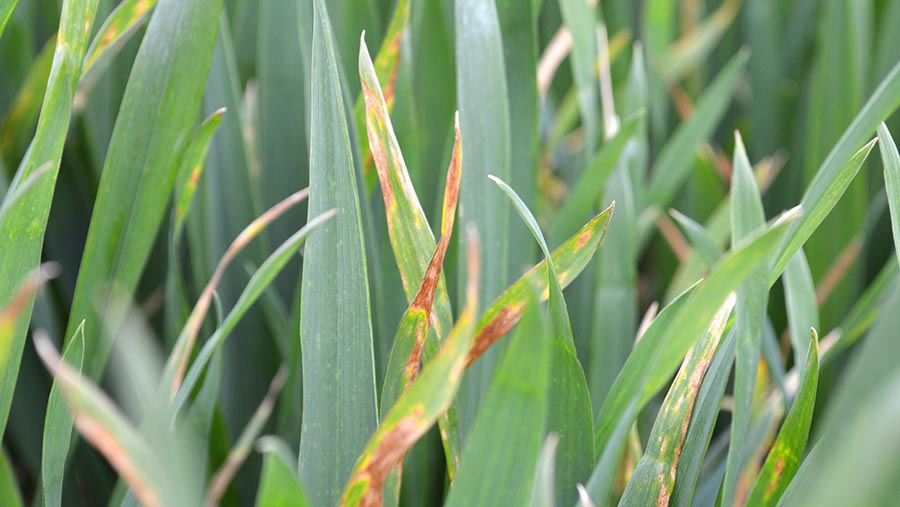How to keep wheat septoria at bay in a high-disease year
 © David Jones
© David Jones Wheat growers may need an extra fungicide spray to keep septoria at bay because of the declining efficacy of some fungicides, with the added benefit of increasing grain yields by more than 1t/ha.
When growing susceptible varieties in a high disease-risk situation, growers should consider a T1.5 spray to protect leaf two from wheat’s most damaging disease, one expert suggests.
As azole and SDHI fungicides are losing their curative kick-back activity when applied at the later T2 flag leaf timing, an early spray may be needed for good disease protection.
Andy Bailey, cereals fungicide technical specialist at agrochemical group Adama, said a multi-site protective fungicide may be needed to protect yield potential at the T1.5 stage.
“Growers should consider a T1.5 spray in certain situations, when a multi-site can protect leaf 2 until the T2 spay,” he said.
See also: How to manage septoria disease in wheat
High risk
This should not be seen as a routine spray, but only considered when septoria risk is high, such as in early-drilled crops, susceptible varieties, wet weather and when the gap between T1 and T2 sprays is stretched.
Trials at the Adas Rosemaund site in the wet climate of Herefordshire showed that when the septoria-susceptible variety Santiago was grown and the T1-T2 spray gap was stretched to five weeks, a big yield response was seen using a multi-site at the T1.5 stage.
“When there is a lot of septoria, a stretched spray interval and a susceptible variety, we can see yield increases of over 1t/ha, as a well-timed multi-site can give good control [over] septoria,” he said.
A multi-site protective fungicide product such as chlorothalonil or folpet would cost growers £7-13/ha.
Company profile
Adama is the fifth-largest agrochemicals group in the UK by sales after Bayer, BASF, Syngenta and the new Dow-DuPont combination.
Emerging leaf 2
Many wheat growers target leaf 3 when it emerges with a T1 spray, usually in late April, and then leaf 1 or the flag leaf with a T2 spray in late May, and treating an emerging leaf 2 is often not a priority when the T2 spray had good curative action.
But as azole and SDHI efficacy declines, the importance of a T1.5 becomes more important.
As leaves can be infected for 14-28 days before visible infection is seen, depending on the temperature, treating each of the top three leaves can be vital in high-risk situations.
His advice is to use a multi-site in a high disease-risk septoria situation and then add a strobilurin if rust is a risk, or an azole if rust is active.
Portfolio changes
Big changes are happening to Adama’s agrochemical portfolio, with some products sold off and the group gaining a key SDHI fungicide for the 2018 season.
In a complex transaction after ChemChina bought Syngenta for US$43bn (£31bn) in May 2017, regulators demanded some sell-offs as both Syngenta and Adama were 100% owned by the Chinese state-controlled group .
As part of the remedy, Adama agreed to sell a collection of products to Australian agrochemicals group Nufarm, and as part of the realignment, Syngenta transferred some of its products to Adama.
This included the SDHI isopyrazam, which is included in SDHI-azole products Keystone and Seguris for wheat and SDHI-based products such as Bontima for barley.
“One of the gaps in our portfolio was an SDHI, so this deal helps our market position,” says Ali Bosher, technical and marketing director at Adama.
Syngenta products marketed by Adama, 2018
SDHIs
- Seguris, Keystone (epoxiconazole + isopyrazam)
- Bontima (cyprodinil + isopyrazam)
- Zulu (straight SDHI)
Insecticides
- Aphox (pirimicarb)
- Karate (pyrethroid lambda-cyhalothrin)
- Plenum (pymetrozine)
Herbicides
- Topik (clodinafop-propargyl)

